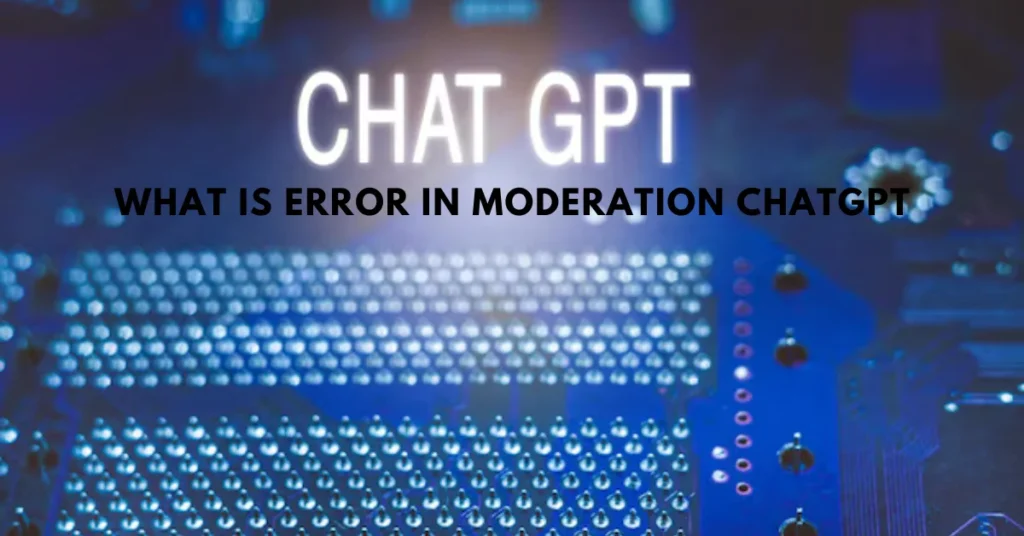what is error in moderation chatgpt
In today’s digital landscape, artificial intelligence has become a powerful tool for enhancing our online interactions. One of the most fascinating advancements is ChatGPT, an AI capable of generating human-like text. However, as with any technology, it’s not without its pitfalls. Among these challenges lies the concept of “error in moderation.” Understanding this term is crucial for anyone using or developing AI systems like what is error in moderation chatgpt.
Errors can lead to confusion and miscommunication, which may compromise user experience. So what exactly does error in moderation mean? And why should we care about managing these errors? Let’s dive into the basics to unravel the complexities behind this important aspect of AI communication and explore how we can improve it.
The Concept of Error in Moderation
Error in moderation refers to the mistakes made during content filtering and control processes. In platforms like ChatGPT, moderation is essential for maintaining a safe and respectful environment.
Errors can occur when inappropriate content slips through or benign messages get flagged mistakenly. These errors not only affect user experience but can also undermine trust in the system.
The complexity of human language adds another layer of difficulty. Sarcasm, cultural references, and nuanced meanings often challenge automated systems.
Understanding these errors requires acknowledging their impact on communication dynamics within digital spaces. It’s crucial for developers to refine algorithms continually, ensuring they adapt to evolving language patterns while minimizing false positives or negatives.
By grasping the concept of error in moderation, we pave the way toward more effective solutions that enhance interaction quality across AI-driven platforms like ChatGPT.
Importance of Managing Error in Moderation
Managing errors in moderation is crucial for maintaining a safe and respectful online environment. When users interact with ChatGPT, they expect accurate responses. A single error can lead to misinformation or misunderstandings.
Mistakes not only affect user experience but can also damage the credibility of the platform. Users may lose trust if they encounter frequent inaccuracies, leading them to seek alternatives.
Moreover, effective error management helps platforms evolve. By identifying common pitfalls, developers can refine algorithms and improve overall functionality. This creates a more robust system that better understands context and nuance.
Additionally, proper handling of errors allows for constructive feedback from users. Such insights are invaluable for continuous improvement and innovation within AI technologies like ChatGPT.
Managing these errors fosters an interactive space where dialogue flourishes rather than falters. It encourages collaboration between users and technology toward achieving successful communication outcomes.
Common Types of Errors in ChatGPT
ChatGPT, while powerful, isn’t immune to errors. One common issue is context misunderstanding. The model may misinterpret user input, leading to irrelevant or nonsensical responses.
Another prevalent error involves factual inaccuracies. ChatGPT might present outdated information or fabricate details that sound plausible but are incorrect.
Bias in responses is also a significant concern. Due to training data influences, the AI can inadvertently reflect societal biases, skewing its output.
Verbosity can be an issue. Sometimes the model generates overly long replies when concise answers would suffice, overwhelming users with unnecessary detail.
These types of errors highlight the ongoing challenges faced by developers and users alike as they navigate interactions with ChatGPT technology.
How to Identify and Correct Errors in Moderation
Identifying errors in moderation requires a keen eye and a systematic approach. Start by reviewing the content generated by ChatGPT carefully. Look for inconsistencies, irrelevant information, or inappropriate language that doesn’t align with community guidelines.
Engaging with users can provide insights into areas of concern. Encourage feedback to discover hidden pitfalls within the system’s responses.
Once errors are identified, correction should be prompt and precise. Adjust settings within the moderation tools to refine how ChatGPT responds to certain topics or queries.
Training your model on diverse datasets can also help limit recurring mistakes in future interactions. Regularly updating these datasets ensures relevance and accuracy over time.
Remember, continuous learning is key in this space. Keep experimenting with different approaches until you find what works best for your specific needs.
Strategies for Minimizing Errors in ChatGPT
Effective training is key. Providing ChatGPT with diverse and high-quality datasets helps it learn better responses.
Regular updates can make a significant difference. Continuously refining models ensures that they stay relevant and accurate.
User feedback plays a vital role too. Encouraging users to report errors allows for quick adjustments and improvements in real time.
Implementing strict guidelines on content moderation will help establish clear boundaries for acceptable output. This reduces ambiguity in responses, leading to fewer mistakes.
Using fallback mechanisms can serve as safety nets. When the AI encounters uncertainty, having predefined protocols guides its next steps effectively.
Collaboration among developers fosters innovation. Sharing insights about common pitfalls leads to shared solutions across teams, enhancing overall performance of the tool.
Conclusion: The Future of ChatGPT and Error Management
The future of ChatGPT holds immense potential, particularly in the realm of error management. As technology continues to evolve, so too will the methods for identifying and rectifying errors in moderation. Enhanced algorithms and advanced machine learning techniques promise greater accuracy and efficiency.
With ongoing developments, users can expect a more robust system that minimizes misunderstandings and improves overall communication. The focus on training models with diverse datasets will also contribute to better context awareness. This shift not only enhances user experience but also builds trust between AI systems and their human counterparts.
As we move forward, fostering an environment where feedback is valued will be crucial. Engaging users as active participants in the process can lead to significant improvements in how errors are managed within ChatGPT.
Managing error effectively is key to unlocking the full potential of artificial intelligence tools like ChatGPT. Embracing these changes paves the way for smoother interactions that benefit both developers and users alike.
FAQs
1. What is “error in moderation” in ChatGPT?
Error in moderation in ChatGPT refers to mistakes made during the content filtering and control processes. It occurs when inappropriate content bypasses moderation filters or when benign content is mistakenly flagged as inappropriate. These errors can affect user experience and trust in the AI system, highlighting the need for continuous refinement in moderation algorithms.
2. Why is managing errors in moderation important for ChatGPT?
Managing errors in moderation is crucial because it ensures a safe and respectful online environment. It helps prevent misinformation, reduces misunderstandings, and maintains user trust. Effective management also supports the evolution of the platform by identifying and addressing common issues, leading to better AI performance and user satisfaction.
3. What are common types of errors encountered in ChatGPT?
Common errors in ChatGPT include context misunderstanding, where the AI misinterprets user input; factual inaccuracies, where outdated or incorrect information is provided; biased responses, reflecting societal biases present in training data; and verbosity, where overly long replies overwhelm users. Each of these errors presents challenges for developers to address.
4. How can errors in moderation be identified and corrected in ChatGPT?
Errors can be identified by carefully reviewing generated content, seeking user feedback, and checking for inconsistencies or inappropriate language. Correction involves adjusting moderation settings, training the model on diverse datasets, and continuously updating the system to address identified issues and improve response accuracy.
5. What strategies can help minimize errors in ChatGPT?
To minimize errors, strategies include providing ChatGPT with diverse and high-quality training datasets, regularly updating the model, incorporating user feedback, implementing clear content moderation guidelines, using fallback mechanisms for uncertainty, and fostering collaboration among developers. These approaches collectively enhance the accuracy and reliability of the AI system.







